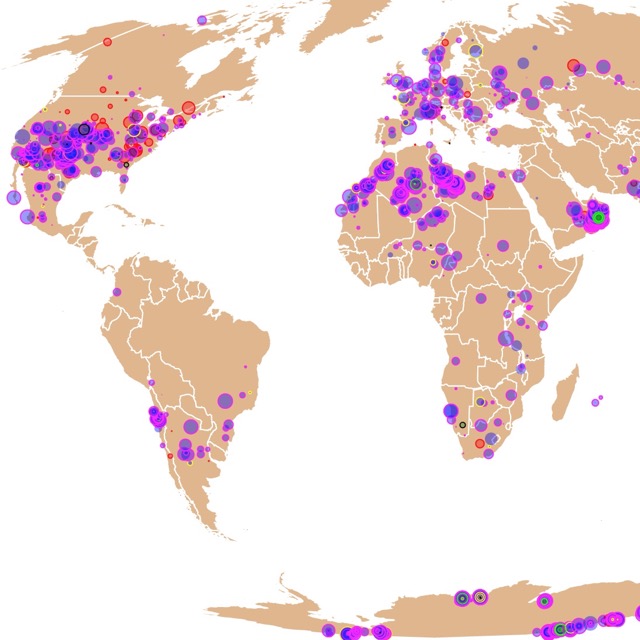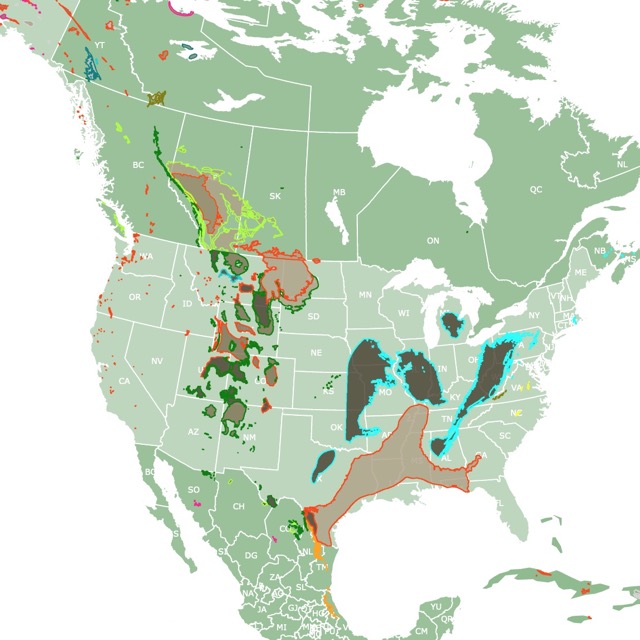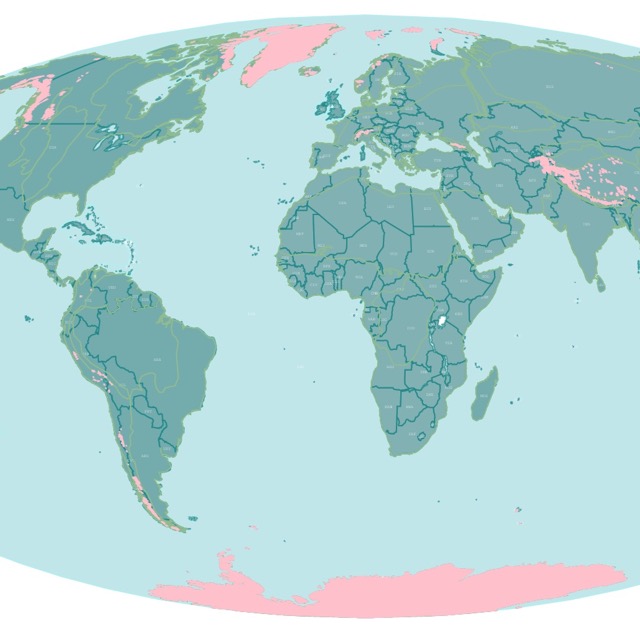Map of Oil and Gas Worldwide
This map shows the world's Assessment Units of undiscovered gas and oil resources. The United States displays Oil and Gas Fields and Plays. The colors depict different types of units and fields. For more detail, hover over the map. To take a closer look, zoom in. For more information, scroll down.
| Field Type | |||
|---|---|---|---|
| Oil | Gas | ||
| Oil and Gas | Shale Plays | ||
Oil and Gas
Oil and natural gas are the major sources of hydrocarbons or organic compounds composed only of carbon and hydrogen.
Hydrocarbons may be gaseous, liquid, or solid. Naturally occurring petroleum is known as “crude oil”. This means it is not “refined”.
What is Oil?
Oil, petroleum, crude oil, or black gold is a fossil fuel. It is also a nonrenewable energy resource.
Crude oil consists of a complex mixture containing between 50 and 95% hydrocarbon by weight.
The remainder comprises organic and inorganic chemical compounds of nitrogen, oxygen, sulfur, and metals such as iron and sodium as salt.
What is Natural Gas?
Natural gas is a fossil fuel and a source of energy. Natural gas contains different compounds.
Its largest component is methane (CH4).
Natural gas also contains smaller amounts of natural gas liquids (NGLs, which are also hydrocarbon gas liquids), and nonhydrocarbon gases, such as carbon dioxide and water vapor; EIA.gov.
For a broad look at petroleum science, Amazon has Elements of Petroleum Geology. This is an introductory text with an account of the physical and chemical properties of petroleum, reviewing methods of petroleum exploration and production.
Oil and Gas Formation
Millions of years ago, microscopic plants and animals died and sank to the bottom of the seafloor. This organic material mixed with other sediments was decomposed by bacteria and was buried.
As time went by, the burial continued while physical processes, low temperatures, and chemical reactions caused more decomposition.
As more time passed and the burial got deeper, the temperature rose, and pressure increased. This resulted in the organic matter decomposing into kerogen.

The kerogen molecules eventually broke up into shorter and lighter molecules composed almost solely of carbon and hydrogen atoms.
The muds compact and become shale. Petroleum is “squeezed” out of the shale and travels through more porous and permeable strata until it encounters a trap. Source: DMR.
Depending on how liquid or gaseous this mixture is, it will turn into either petroleum or natural gas.
Evidence of Oil Formation
- Oil occurs in sedimentary rocks.
- It is found in continental or marine sediments that were not metamorphosed.
- It is rarely found in rocks formed before life developed on Earth.
- It contains similar compounds found in living organisms.
Oil Extraction
Oil is found in specific underground rocks called reservoirs. These rocks have tiny spaces in them that allow them to hold water, natural gas, and/or oil.
Impermeable rocks called cap rocks surround the reservoir and trap oil in its place.
Conventional oil is held in these traps or reservoirs of porous and permeable rock.
Unconventional oil, primarily shale oil is held tightly in non-permeable shale deposits and thus more difficult to extract. This type of oil requires hydraulic fracturing to access.
Unconventional resources include heavy oil, tar sands, shale gas, shale oil, tight gas, and coalbed gas.
Generally, extraction requires a well that is drilled into a reservoir containing crude oil.
The well can be vertical, directional, or horizontal depending on how much access to the deposit is needed.
Directional and horizontal drilling allows more of the well to be in the deposit itself, increasing the flow of the oil.
Once the oil is extracted and refined, it can be distilled or undergo hydrocarbon cracking to form products and fuels; Energy Ed.
World Oil Reserves
In 2021 BP Plc estimates that there are 1.73 trillion barrels of oil reserves in the world. This number varies yearly as new studies and estimates are published.
The world has proven reserves equivalent to 46.6 times its annual consumption levels. This means it has about 47 years of oil left (at current consumption levels and excluding unproven reserves) as of 2016. Source: Worldmeter.
For more information about oil reserves, Amazon sells Too Much by Half: The Coming Cut in Proved Oil Reserves. This book reads mostly as memoir, telling the story as a chronology of projects in which the author was retained as a consulting engineer to estimate, develop and produce reserves.
Oil Reserves and Daily Production
The following table includes the 15 countries with the most Oil reserves and production. This data is from 2017. Source: USA Today.
| Country | Oil Reserves | Daily Oil Production |
|---|---|---|
| Venezuela | 303.2 billion barrels (17.9% of the world total) | 2.1 million barrels |
| Saudi Arabia | 266.2 billion barrels (15.7% of the world total) | 12 million barrels |
| Canada | 168.9 billion barrels (10% of the world total) | 4.8 million barrels |
| Iran | 157.2 billion barrels (9.3% of the world total) | 5 million barrels |
| Iraq | 148.8 billion barrels (8.8% of the world total) | 4.5 million barrels |
| Russian Federation | 106.2 billion barrels (6.3% of the world total) | 11.3 million barrels |
| Kuwait | 101.5 billion barrels (6% of the world total) | 3 million barrels |
| United Arab Emirates | 97.8 billion barrels (5.8% of the world total) | 3.9 million barrels |
| United States | 50.0 billion barrels (2.9% of the world total) | 13.1 million barrels |
| Libya | 48.4 billion barrels (2.9% of the world total) | 865,000 barrels |
| Nigeria | 37.5 billion barrels (2.2% of the world total) | 2 million barrels |
| Kazakhstan | 30 billion barrels (1.8% of the world total) | 1.8 million barrels |
| China | 25.7 billion barrels (1.5% of the world total) | 3.8 million barrels |
| Qatar | 25.2 billion barrels (1.5% of the world total) | 1.9 million barrels |
| Brazil | 12.8 billion barrels (0.8% of the world total) | 2.7 million barrels |
United States Oil Production
The United States has 50 billion barrels of proven oil reserves, more than all but eight other countries worldwide.
This is equal to 2.9% of the world's proven oil reserves.
The United States also produces an average of 13.1 million barrels per day, the most of any country in the world and equal to 14.1% of daily global oil production.
In 2021, 71% of total U.S. oil production comes from just five states. An additional 15.2% comes from the Gulf of Mexico, which is a federal jurisdiction.
These states are Texas, North Dakota, New Mexico, Alaska, and Colorado. Source: EIA.
The state of Texas accounts for over a third of all oil production in the country.
The U.S. consumes more oil than any other country. It burns over 913.3 million tons of oil a year, about 50% more than China, the world's second-largest consumer of oil.
Petroleum accounted for about 9% of the $2.2 trillion in imports to the United States in 2017.
The U.S. is also home to some of the largest energy companies in the world by revenue, including ExxonMobil and Chevron.
Venezuela's Oil
Venezuela has 303.2 billion barrels worth of oil in the country, nearly 18% of global reserves.
This country is highly dependent on oil, with petroleum accounting for over 90% of total exports.
The country's current crisis is partially the result of spending oil revenues on social services rather than reinvesting in aging oil extraction infrastructure.
Saudi Arabia's Oil
Saudi Arabia has the most oil reserves of any OPEC (Organization of the Petroleum Exporting Countries) nation and the second most of any country in the world.
The country's daily production is more than every country other than the United States.
Heavily dependent on its oil industry, Saudi Arabia derived more than 75% of its $170 billion in 2017 export revenue from petroleum.
Russian Federation Oil
Russia is the largest country in the world by landmass.
Along with the U.S. and Saudi Arabia, Russia is one of only three countries in the world producing more than 10 million barrels of oil per day.
Petroleum accounted for over half of the country's $341 billion in exports.
Russia's economy, which relies heavily on oil revenue, has been hurt in recent years by economic sanctions.
These sanctions have been imposed following the country's 2014 invasion of the Crimean Peninsula and the 2021 invasion of Ukraine.
American-imposed sanctions specifically target Russia's energy companies.
If you want to read more about this industry, Amazon sells Fundamentals of Oil & Gas Industry for Beginners. This book looks at the politics, economics, global relations, business establishments, and policy of oil.
Arctic Oil and Gas
The Arctic has large oil and natural gas resources, onshore and offshore. Nevertheless, its extreme weather and remote location make its production expensive and hazardous.
In recent decades climate change with warmer summers has resulted in decreased summer sea ice. This in turn has increased shipping traffic. This low sea ice may encourage offshore oil and gas exploration as well! Geoscience.
U.S. Geological Survey estimates that the Arctic contains approximately 13% of the world's undiscovered conventional oil resources and about 30% of its undiscovered conventional natural gas resources.
The Arctic holds about 22% of the world’s undiscovered conventional oil and natural gas resources.
Arctic oil and natural gas resources are not evenly distributed. Eurasia is estimated to hold about 63% of the total Arctic resource base, while North America holds about 36%.
Eurasia is more natural-gas prone, while North America is more oil-prone. The Arctic Alaska region is estimated to hold the largest undiscovered Arctic oil deposits, about 30 billion barrels; EIA.
Exploiting the Arctic's oil in Alaska would require permission from the Arctic National Wildlife Refuge and from State and Native Lands.
The main question regardless of the permissions and the costs is the envirnmental impact on the whole region.

Oil and Gas Map
This map was made using different sources. Oil and Gas Fields for the United States and Assessment Units for the rest of the World.
Oil and Gas Assessment Units
Assessment Units are geographic boundaries defined, as a set of known oil and (or) gas accumulations. They share similar geologic, geographic, and temporal properties.
They assess the potential for undiscovered oil and gas resources in priority geologic provinces in the World USGS.
Unfortunately not all oil and gas-bearing provinces are included on the map.
On the map, Assessment Units are used for most of the world except for the United States.
The values presented are estimates based on previous studies.
Oil and Gas Fields
The United States Oil and Gas is represented as Oil and Natural Gas Fields. Oil and Gas Fields are "a low in the Earth’s crust of tectonic origin in which sediments have accumulated". This definition was originally articulated by the Bureau of Land Management.
In the United States, you will find smaller features called "plays". Plays are “A set of known or postulated oil and gas accumulations sharing similar geologic, geographic, and temporal properties, such as source rock, migration, pathway, timing, trapping mechanism, and hydrocarbon type. A play differs from a basin; a basin can include one or more plays.” Source: HIFLD.
The plays are depicted in Mexico, the United States, and Canada.
According to U.S. Geological Survey" "Assessment units are therefore more closely associated with the generation and migration of petroleum than are plays."
"The choice of play versus assessment unit probably does not result in significant systematic differences in assessed undiscovered resources. However, the total petroleum system and its assessment units provide a more comprehensive and unifying framework for studying oil and gas accumulations."
Resources for Oil and Gas Reservoirs
The shapefiles with the countries of the world were obtained from Natural Earth.
Arctic Assessment Units are from United States Geological Survey, 2008, Circum-Arctic Resource Appraisal (north of the Arctic Circle) Assessment Units: U.S. Geological Survey data release, https://doi.org/10.5066/P9K1A53L. The shapefiles were downloaded from Sciencebase.gov.
Oil and Natural Gas Fields from the United States shapefiles were downloaded from Homeland Infrastructure Foundation- Level Data.
The Assessment Units for the rest of the world were downloaded from USGS.
This map will be updated with new data! To receive updates on this and more nature maps, join my email list!!!!!!!
Made by Luz K. Molina with D3.js.










